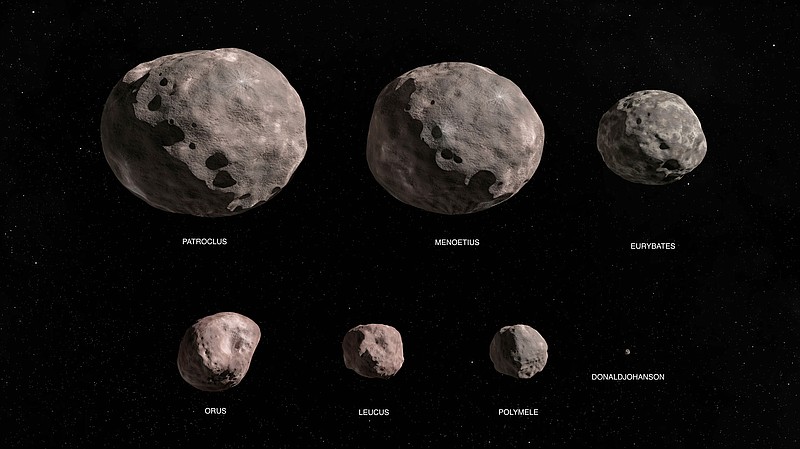NASA’s Lucy probe, launched Oct. 16, will arrive at its first target — an asteroid between Mars and Jupiter named 52246 Donaldjohanson, after the discoverer of the Lucy skeleton — in 2025. This is not a Trojan asteroid and is more like a rehearsal flyby for the mission.
During observation campaigns, scientists discovered that Donaldjohanson is most likely only 100 million years old, making it one of the youngest objects in the solar system.
Two years later, the spacecraft will fly by the first Trojan asteroid, 3548 Eurybates, which also has a tiny moon, Queta. Eurybates was once part of another destroyed asteroid. Such an origin might also explain its moon.
The second target, 15094 Polymele, is the smallest of the not-moon targets for Lucy. Planetary scientists will be looking closely at its surface features and density. In general, objects that formed closer to the sun are denser than objects that formed farther away.
The spacecraft will next fly by the asteroid 11351 Leucus, which is a "slow rotator," whose day lasts about 400 hours. Its shape is of particular interest. The final asteroid of the first loop of Lucy's trajectory is 21900 Orus. Scientists are interested in differences between its terrain and that of Eurybates.
In 2028, Lucy will begin its sweep from one side of the solar system to the other to visit the opposite Trojan swarm. After swinging past Earth to pick up speed, the spacecraft will, in 2033, fly to 617 Patroclus and Menoetius, binary asteroids that rotate around a common center of mass. These are among the largest known Trojan bodies, and scientists want to know whether their pairing is a sign that they came from farther out in the solar system, where such binaries are more common.
If Lucy returns data suggesting that the Trojans formed in different places at different distances from the sun and were then swept into their current orbits, it would be significant corroborating evidence for the Nice model.
On the other hand, when Lucy's data might reveal something entirely unexpected about how the solar system evolved. That, says the mission's leader, would be a good thing.
Planetary scientist Hal Levison and fellow theorists developed the Nice model of solar system evolution.
"My hope," Levison said, "will be to look at the current models of solar system formation — including my own work — and say: 'Nope, this is all wrong. It wasn't that simple, and we have to start again.'"
[RELATED: Powered by the sun, Lucy space probe to collect clues to universe’s origin]
